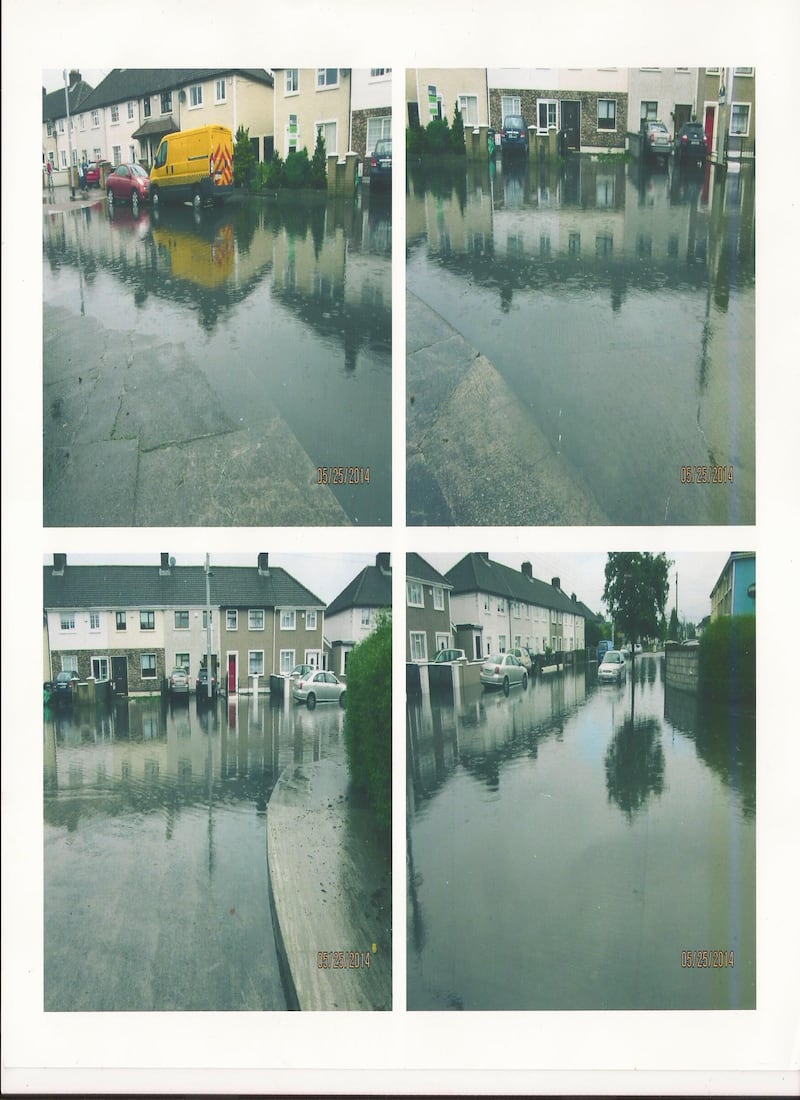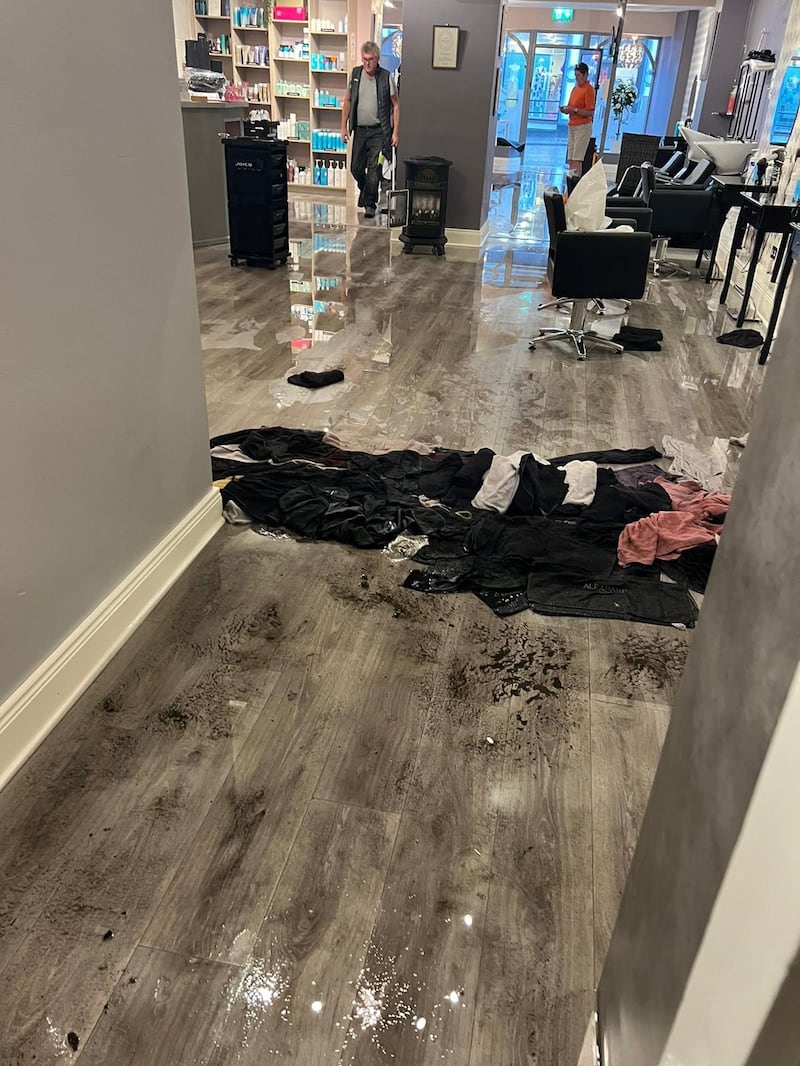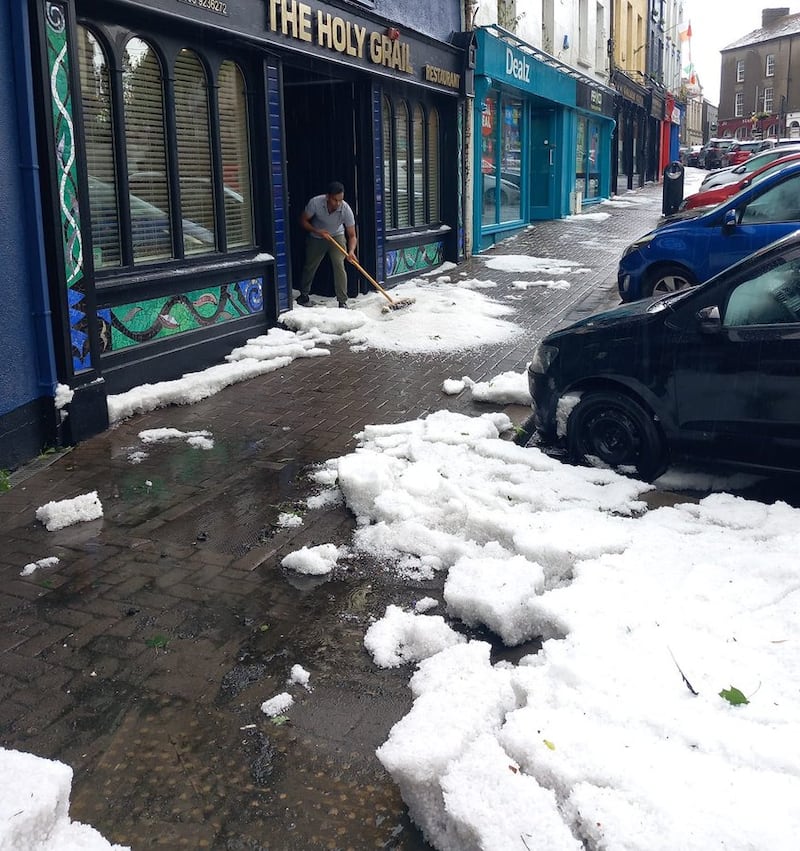When Ken Duffy first moved into his home on Mourne Road in Drimnagh in Dublin five years ago, he discovered that the previous occupier had left a number of sandbags behind.
He soon learned why. Duffy and his partner Noelle had lived in the property for only a few months when they first witnessed flooding on the street. And that was only the start of it.
“It’s happened twice in the last two weeks,” Duffy says, sitting in the front room of his terraced house on Thursday.
On a neatly paved driveway to the front of the house, a single collapsed sandbag sits on top of an exposed vent.
RM Block
He explains that there was severe flooding on the road on June 20th. After a torrential downpour, manholes dotted along it turned into geysers, spewing wastewater which combined with the heavy rainfall to completely flood the road and driveways of several houses. Duffy spent that afternoon blocking off homes vulnerable to flooding using sandbags, and directing traffic away from the area.
Previous instances of flooding have, he says, resulted in cars being written off on the road, and the interiors of some properties being damaged by sewage.
[ Flooding in parts of Dublin and Kerry as ‘extremely intense’ rainfall recordedOpens in new window ]
During a walk down Mourne Road, Duffy greets John Keane, who is pruning flowers in a hanging basket outside his home. Keane has lived on the street since 1969. Years ago, he says, flooding might occur in the area once in a blue moon. But now, it happens frequently.
Oil and grease
Dublin City Council (DCC) last year identified a number of issues within the locality’s historic drainage system, says Colm Fitzpatrick, the council’s executive manager for waste and wastewater services.
The authority worked to clear tree roots and a build-up of fats, oil and grease from drainage pipes late last year, he says, but the flooding has continued to happen.

“It’s incredibly distressing,” Duffy says. “It’s always there, this could happen at any moment. There’s never any warning.”
He suggests that climate change has a part to play in the rainfall events that have triggered flooding in recent years.
“I think a lot of people, especially in this country, seem to view [climate change] as an abstract concept, ‘it may happen’,” he adds. “We don’t have to look to Mauritius to see evidence – all we need to do is look out the window.”
Last month, when Drimnagh, other parts of the capital, and areas of Co Wexford and Co Kerry experienced flooding, was, according to Met Éireann provisional statistics, the warmest June on record. The average temperature of 16.2 degrees represented a significant increase (0.8 degrees) on the previous warmest June.
“It’s part of an observed warming trend that’s been going on, and that the climate projections have been projecting to happen,” says Met Éireann meteorologist Paul Moore.
And while it is relatively normal to have cases of “convective, extreme” rainfall during the summer, current trends point to these events becoming heavier and more extreme, he notes. “Because there’s more energy in the atmosphere – a warmer world, one degree warmer, can hold 7 per cent more moisture.”
‘Beyond doubt’
It is not possible to directly link individual instances of adverse weather – such as localised flooding – to climate change, he adds. “But you can say that it is part of the trend that we’re seeing, and that we’re likely to see an increase of in the future.
“It’s beyond doubt that this climate change, this warming, is caused by an increase in greenhouse gases in the atmosphere caused by humans.”
On June 20th, for the second time in three years, Tracey Grimes’s hair and beauty salon in Listowel, Co Kerry, was flooded after heavy rainfall.
“Your livelihood is completely and utterly impacted ... it puts on a ferocious amount of pressure,” she says.

Grimes agrees that recent adverse weather events may be linked to climate change trends. “The weather’s getting hotter, but it’s [also] getting wetter.”
Two weeks ago, the heavy rain caused two manholes in proximity to her premises to gush sewage.

Her insurance will cover the high costs involved in repairing the salon this time around – cleaning, drying, repainting, replacing floorboards. But if it happens again, she worries she will have to foot the bill herself.
“And unless they do something, the likelihood is that it will happen again,” she says.
Severe flooding
Wickham’s Butchers, established in Enniscorthy, Co Wexford in 1961, continues to grapple with the costs of damage caused by severe flooding and hail in the town last month. The premises also flooded three years ago.

Noreen Whelan says her brother, Mark Wickham, who currently runs the butcher shop and deli, is considering closing the shop.
“Everything is up in the air at the moment,” she says.
Whelan raises a theory similar to the residents of Mourne Road: that the impacts of climate change, coupled with perceived inadequacies with drainage systems, are the causes of recent flooding.
[ Facing hell and high water: The parts of Ireland threatened by rising floodwatersOpens in new window ]
“I do think that towns and villages around the country will have to change their infrastructure to be able to cope with the amount of water that falls,” she says.
Ray Murphy, senior assistant chief fire officer with Wexford County Fire Service, is often tasked with responding to weather events such as last month’s flooding in Enniscorthy.
Local authorities such as those in Wexford and Dublin city try to get ahead of adverse weather events through monitoring and forecasting, and allocate resources accordingly.
But, Murphy says, many drainage systems are not designed for “and just aren’t able to cope” with the extent of the excess water produced by these events.
‘Significant capital investment’
Upgrading the drainage system at Mourne Road would represent a “significant capital investment”, says DCC’s Fitzpatrick. The council is exploring more sustainable and nature-based flood defence mechanisms, he says, such as swales – shallow, grass-covered channels designed to retain and direct excess water or runoff.
Duffy says a better drainage system is “the thin end of the wedge” when it comes to the impacts of changing climate patterns. “I think there has to be a comprehensive approach and forward planning on this.”
Daithí Doolan, a Sinn Féin councillor in Dublin city, submitted an emergency motion to a meeting of the council’s South Central Area Committee on June 21st, calling for an investigation into the causes of flooding on Mourne Road, and for potential preventive measures to be explored.
The findings of the investigation are expected in September.
Any planning decision must account for the impact of changing climate pattern, says Fitzpatrick. “We’re very cognisant of current trends, and climate is, and weather patterns are changing, and not just in Ireland.”


















